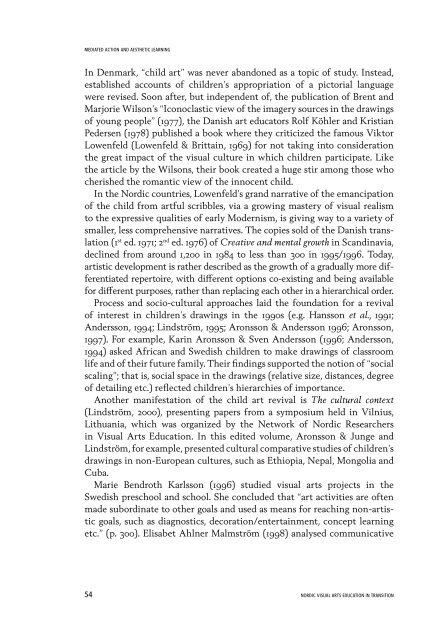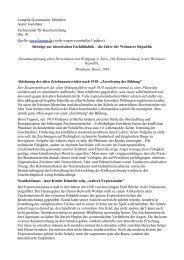Research in Visual Arts Education - The National Society for ...
Research in Visual Arts Education - The National Society for ...
Research in Visual Arts Education - The National Society for ...
You also want an ePaper? Increase the reach of your titles
YUMPU automatically turns print PDFs into web optimized ePapers that Google loves.
MEDIATED ACTION AND AESTHETIC LEARNING<br />
In Denmark, “child art” was never abandoned as a topic of study. Instead,<br />
established accounts of children’s appropriation of a pictorial language<br />
were revised. Soon after, but <strong>in</strong>dependent of, the publication of Brent and<br />
Marjorie Wilson’s “Iconoclastic view of the imagery sources <strong>in</strong> the draw<strong>in</strong>gs<br />
of young people” (1977), the Danish art educators Rolf Köhler and Kristian<br />
Pedersen (1978) published a book where they criticized the famous Viktor<br />
Lowenfeld (Lowenfeld & Britta<strong>in</strong>, 1969) <strong>for</strong> not tak<strong>in</strong>g <strong>in</strong>to consideration<br />
the great impact of the visual culture <strong>in</strong> which children participate. Like<br />
the article by the Wilsons, their book created a huge stir among those who<br />
cherished the romantic view of the <strong>in</strong>nocent child.<br />
In the Nordic countries, Lowenfeld’s grand narrative of the emancipation<br />
of the child from artful scribbles, via a grow<strong>in</strong>g mastery of visual realism<br />
to the expressive qualities of early Modernism, is giv<strong>in</strong>g way to a variety of<br />
smaller, less comprehensive narratives. <strong>The</strong> copies sold of the Danish translation<br />
(1 st ed. 1971; 2 nd ed. 1976) of Creative and mental growth <strong>in</strong> Scand<strong>in</strong>avia,<br />
decl<strong>in</strong>ed from around 1,200 <strong>in</strong> 1984 to less than 300 <strong>in</strong> 1995/1996. Today,<br />
artistic development is rather described as the growth of a gradually more differentiated<br />
repertoire, with different options co-exist<strong>in</strong>g and be<strong>in</strong>g available<br />
<strong>for</strong> different purposes, rather than replac<strong>in</strong>g each other <strong>in</strong> a hierarchical order.<br />
Process and socio-cultural approaches laid the foundation <strong>for</strong> a revival<br />
of <strong>in</strong>terest <strong>in</strong> children’s draw<strong>in</strong>gs <strong>in</strong> the 1990s (e.g. Hansson et al., 1991;<br />
Andersson, 1994; L<strong>in</strong>dström, 1995; Aronsson & Andersson 1996; Aronsson,<br />
1997). For example, Kar<strong>in</strong> Aronsson & Sven Andersson (1996; Andersson,<br />
1994) asked African and Swedish children to make draw<strong>in</strong>gs of classroom<br />
life and of their future family. <strong>The</strong>ir f<strong>in</strong>d<strong>in</strong>gs supported the notion of “social<br />
scal<strong>in</strong>g”; that is, social space <strong>in</strong> the draw<strong>in</strong>gs (relative size, distances, degree<br />
of detail<strong>in</strong>g etc.) reflected children’s hierarchies of importance.<br />
Another mani festation of the child art revival is <strong>The</strong> cultural context<br />
(L<strong>in</strong>dström, 2000), present<strong>in</strong>g papers from a symposium held <strong>in</strong> Vilnius,<br />
Lithuania, which was organized by the Network of Nordic <strong>Research</strong>ers<br />
<strong>in</strong> <strong>Visual</strong> <strong>Arts</strong> <strong>Education</strong>. In this edited volume, Aronsson & Junge and<br />
L<strong>in</strong>dström, <strong>for</strong> example, presented cultural com parative studies of children’s<br />
draw<strong>in</strong>gs <strong>in</strong> non-European cultures, such as Ethiopia, Nepal, Mongolia and<br />
Cuba.<br />
Marie Bendroth Karlsson (1996) studied visual arts projects <strong>in</strong> the<br />
Swedish preschool and school. She concluded that “art activities are often<br />
made subord<strong>in</strong>ate to other goals and used as means <strong>for</strong> reach<strong>in</strong>g non-artistic<br />
goals, such as diagnostics, decoration/enterta<strong>in</strong>ment, concept learn<strong>in</strong>g<br />
etc.” (p. 300). Elisabet Ahlner Malmström (1998) analysed communicative<br />
54 NORDIC VISUAL ARTS EDUCATION IN TRANSITION



